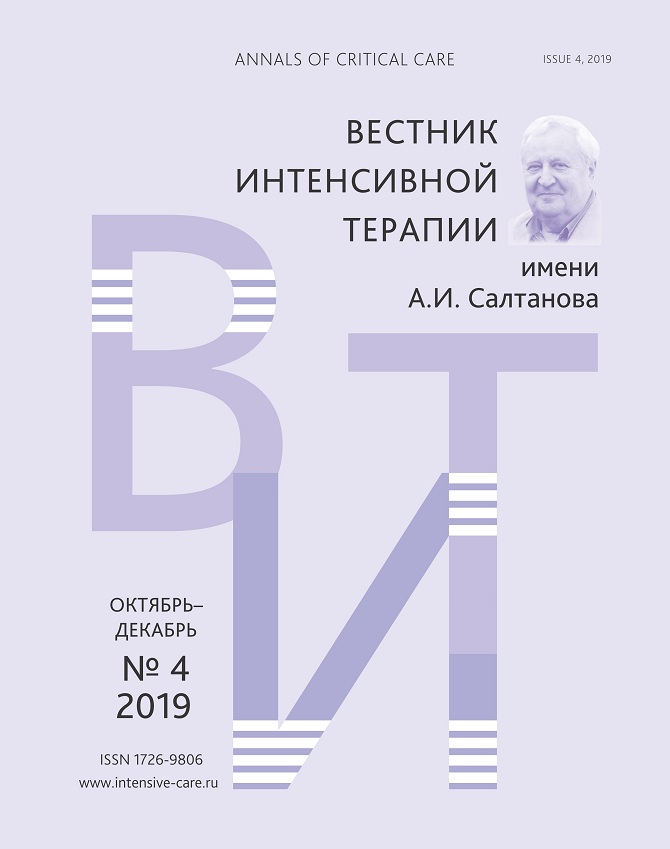Аннотация
Актуальность. В настоящее время положение пациента сидя во многом утратило популярность среди нейрохирургов в основном из-за опасений возможных осложнений. Эта позиция сопряжена с определенными рисками, наиболее опасными из которых являются венозная воздушная (ВВЭ) и парадоксальная воздушная эмболия (ПВЭ).
Материалы и методы. Мы сообщаем о ретроспективном исследовании, в которое за 2 года вошло 66 нейрохирургических пациентов, оперированных в положении сидя. Предоперационное обследование, анестезиологическое обеспечение и интраоперационный мониторинг были стандартизированы. В анализ были включены данные из анестезиологических карт и протоколов интраоперационного мониторинга.
Результаты. Из 66 пациентов у 24 (36 %) было диагностировано функционирующее овальное окно (ФОО) с помощью контрастной трансэзофагеальной эхокардиографии с пробой Вальсальвы. Выявленная аномалия не рассматривалась как противопоказание для хирургического вмешательства в положении сидя. Венозная воздушная эмболия во время операции была диагностирована у 34 пациентов (51,5 %). Однако клинически значимые осложнения развились у 3 пациентов (4,5 %). Ни у одного пациента не было осложнений, требующих терапии в послеоперационном периоде.
Заключение. Наше исследование показывает, что модель анестезиологического обеспечения, подобная нашей, эффективна в предотвращении основных осложнений, связанных с положением пациента сидя. Страх перед фатальными осложнениями представляется необоснованным.
Библиографические ссылки
- Harrison E.A., Mackersie A., McEwan A., Facer E. The sitting position for neurosurgery in children: a review of 16 years’ experience. Br J Anaesth. 2002; 88(1): 12–17. DOI:10.1093/bja/88.1.12
- Orliaguet G.A., Hanafi M., Meyer P.G., et al. Is the sitting or the prone position best for surgery for posterior fossa tumours in children? Paediatr Anaesth. 2001; 11(5): 541–547. DOI:10.1046/j.1460-9592.2001.00733.x
- Fathi A.-R., Eshtehardi P., Meier B. Patent foramen ovale and neurosurgery in sitting position: a systematic review. Br J Anaesth. 2009; 102(5): 588–596. DOI:10.1093/bja/aep063
- Young M.L., Smith D.S., Murtagh F., et al. Comparison of surgical and anesthetic complications in neurosurgical patients experiencing venous air embolism in the sitting position. Neurosurgery. 1986; 18(2): 157–161. DOI:10.1227/00006123-198602000-00007
- Matjasko J., Petrozza P., Cohen M., Steinberg P. Anesthesia and Surgery in the Seated Position: Analysis of 554 Cases. Neurosurgery. 1985; 17(5): 695–702. DOI:10.1227/00006123-198511000-00001
- Standefer R., et al. The Sitting Position in Neurosurgery: A Retrospective Analysis of 488 Cases. Neurosurgery. 1984; 14(6): 649–658. DOI:10.1227/00006123-198406000-00001
- Albin M.S., Carroll R.G., Maroon J.C. Clinical Considerations Concerning Detection of Venous Air Embolism. Neurosurgery. 1978; 3(3): 380–384. DOI:10.1227/00006123-197811000-00009
- Basaldella L., Ortolani V., Corbanese U., et al. Massive venous air embolism in the semi-sitting position during surgery for a cervical spinal cord tumor: anatomic and surgical pitfalls. J Clin Neurosci. 2009; 16(7): 972–975. DOI:10.1016/J.JOCN.2008.10.005
- Israelyan L.A., Shimanskiy V.N., Otamanov D.A., et al. Patient positioning on the operating table in neurosurgery: sitting or lying. Russian journal of Anaesthesiology and Reanimatology. 2013; 80(2013): 18–26.
- Palmon S.C., Moore L.E., Lundberg J., Toung T. Venous air embolism: A review. J Clin Anesth. 1997; 9: 251-257. DOI:10.1016/S0952-8180(97)00024-X
- Jadik S., Wissing H., Friedrich K., et al. A standardized protocol for the prevention of clinically relevant venous air embolism during neurosurgical interventions in the semisitting position. Neurosurgery. 2009; 64(3): 533–539. DOI:10.1227/01.NEU.0000338432.55235.D3
- Averyanov D.A., Lakotko R.S., Khomenko E.A., Shchegolev A.V. Patent Foramen Ovale Incidence and Severity in Neurosurgical Patients. Russian journal of Anaesthesiology and Reanimatology. 2018; 3: 54–57. DOI:10.17116/anaesthesiology201803154
- Majd R.E., Kavarana M.N., Bouvette M., Dowling R.D. Improved Technique to Diagnose a Patent Foramen Ovale During Left Ventricular Assist Device Insertion. Ann Thorac Surg. 2006; 82(5): 1917–1918. DOI:10.1016/J.ATHORACSUR.2005.09.030
- Christin F., Bouffard Y., Rossi R., Delafosse B. Paradoxical Symptomatic Air Embolism after Saline Contrast Transesophageal Echocardiography. Echocardiography. 2007; 24(8): 867–869. DOI:10.1111/j.1540-8175.2007.00489.x
- Porter J.M., Pidgeon C., Cunningham A.J. The sitting position in neurosurgery: A critical appraisal. Br J Anaesth. 1999; 82(1): 117–128. DOI:10.1093/bja/82.1.117
- Babichev K.N., Stanishevskiy A.V., Svistov D.V., et al. Surgical resection of fourth ventricular tumors. Comparison of the efficiency and safety of telovelar and median aperture approaches to the fourth ventricle. Russian journal of neurosurgery. 2018; 20(4): 10–19. DOI:10.17650/1683-3295-2018-20-4-10-19
- Feigl G.C., Decker K., Wurms M., et al. Neurosurgical procedures in the semisitting position: Evaluation of the risk of paradoxical venous air embolism in patients with a patent foramen ovale. World Neurosurg. 2014; 81(1): 159–164. DOI:10.1016/j.wneu.2013.01.003
- Faberowski L.W., Black S., Mickle J.P. Incidence of Venous Air Embolism during Craniectomy for Craniosynostosis Repair. Anesthesiol J Am Soc Anesthesiol. 2000; 92(1): 20–20. DOI:10.1097/00006123-199909000-00208
- Luostarinen T., Lindroos A.-C., Niiya T., et al. Prone Versus Sitting Position in Neurosurgery – Differences in Patients’ Hemodynamic Management. World Neurosurg. 2017; 97: 261–266. DOI:10.1016/j.wneu.2016.10.005
- Lindroos A.-C., Niiya T., Randell T., et al. Sitting Position for Removal of Pineal Region Lesions: The Helsinki Experience. World Neurosurg. 2010; 74(4–5): 505–513. DOI:10.1016/j.wneu.2010.09.026
- Stendel R., Gramm H.J., Schröder K., et al. Transcranial doppler ultrasonography as a screening technique for detection of a patent foramen ovale before surgery in the sitting position. Anesthesiology. 2000; 93(4): 971–975. DOI:10.1097/00000542-200010000-00016
- Gale T., Leslie K. Anaesthesia for neurosurgery in the sitting position. J Clin Neurosci. 2004; 11(7): 693–696. DOI:10.1016/j.jocn.2004.05.007
- Black S., Ockert D.B., Oliver W.C., Cucchiara R.F. Outcome following posterior fossa craniectomy in patients in the sitting or horizontal positions. Anesthesiology. 1988; 69(1): 49–56. DOI:10.1097/00000542-198807000-00008
- Ammirati M, Lamki T.T., Shaw A.B., et al. A streamlined protocol for the use of the semi-sitting position in neurosurgery: A report on 48 consecutive procedures. J Clin Neurosci. 2013; 20(1): 32–34. DOI:10.1016/j.jocn.2012.05.037
- Leslie K., Hui R., Kaye A.H. Venous air embolism and the sitting position: A case series. J Clin Neurosci. 2006; 13(4): 419–422. DOI:10.1016/j.jocn.2005.08.007
- Tobias J.D., Johnson J.O., Jimenez D.F., et al. Venous Air Embolism during Endoscopic Strip Craniectomy for Repair of Craniosynostosis in Infants. Anesthesiology. 2001; 95(2): 340–342. DOI:10.1097/00000542-200108000-00013
- Ganslandt O., Merkel A., Schmitt H., et al. The sitting position in neurosurgery: indications, complications and results. a single institution experience of 600 cases. Acta Neurochir (Wien). 2013; 155(10): 1887–1893. DOI:10.1007/s00701-013-1822-x
- Giebler R., Kollenberg B., Pohlen G., Eters J. Effect of Positive End-Expiratory Pressure on the Incidence of Venous Air Embolism and on the Cardiovascular Response to the Sitting Position During Neurosurgery. Surv Anesthesiol. 1998; 42(5): 272. DOI:10.1097/00132586-199810000-00022


